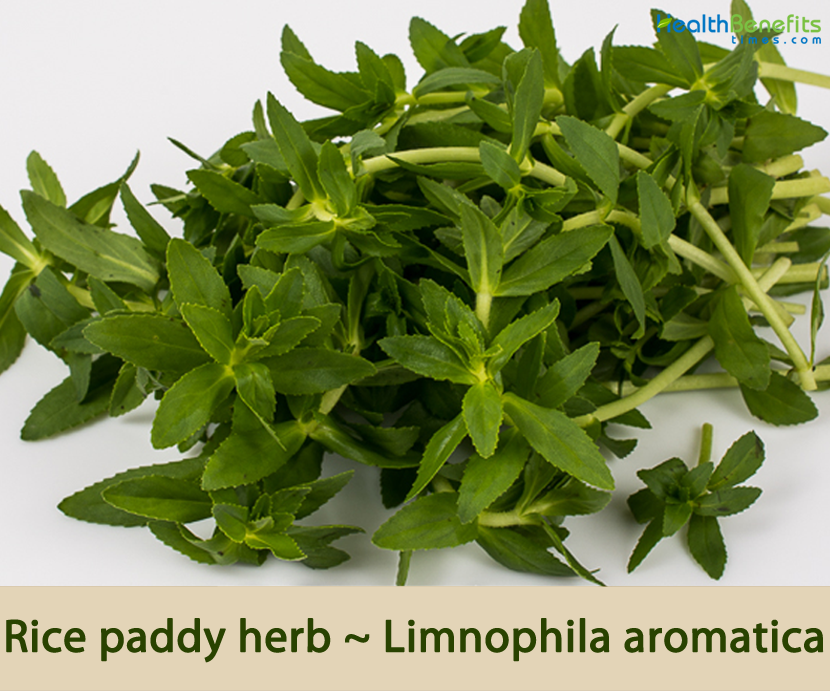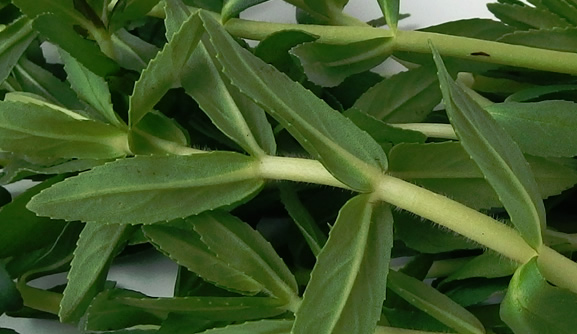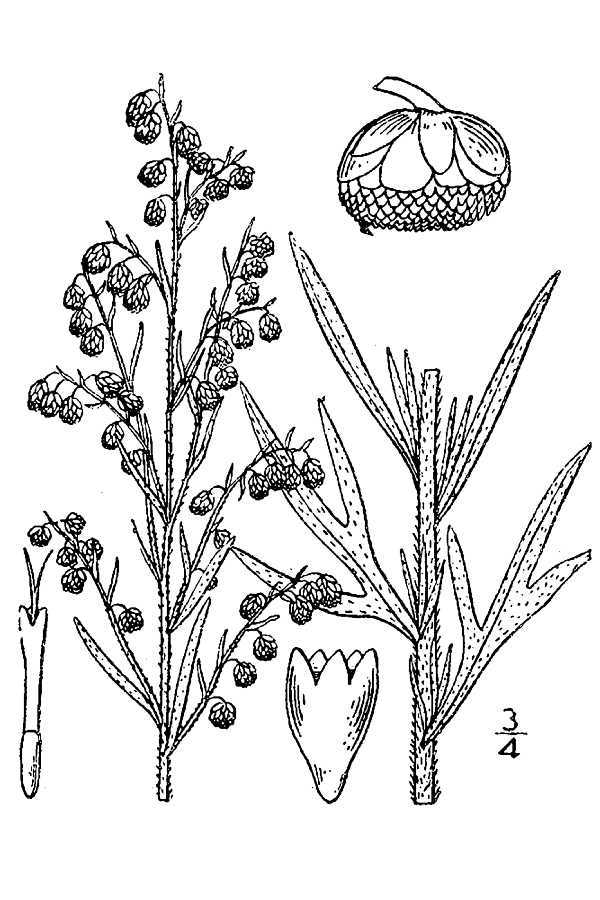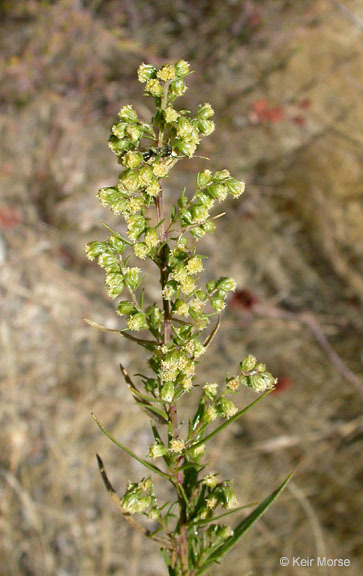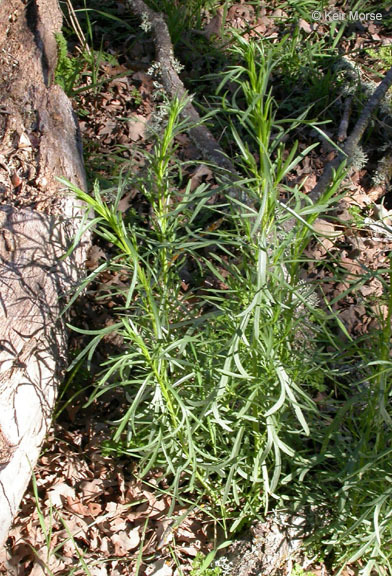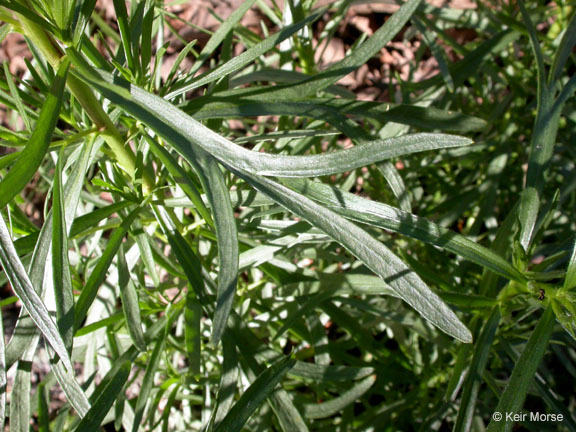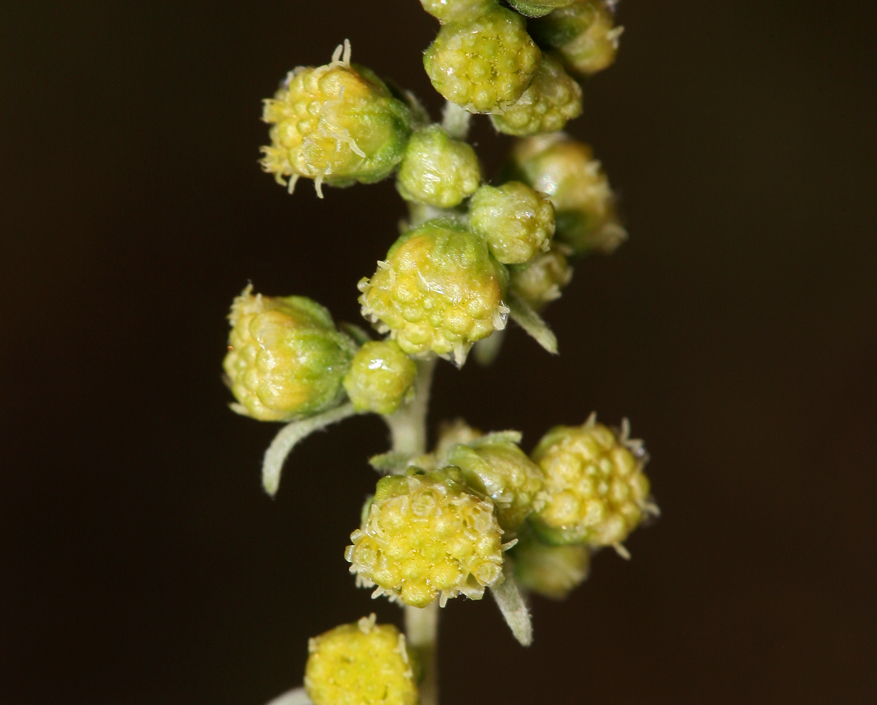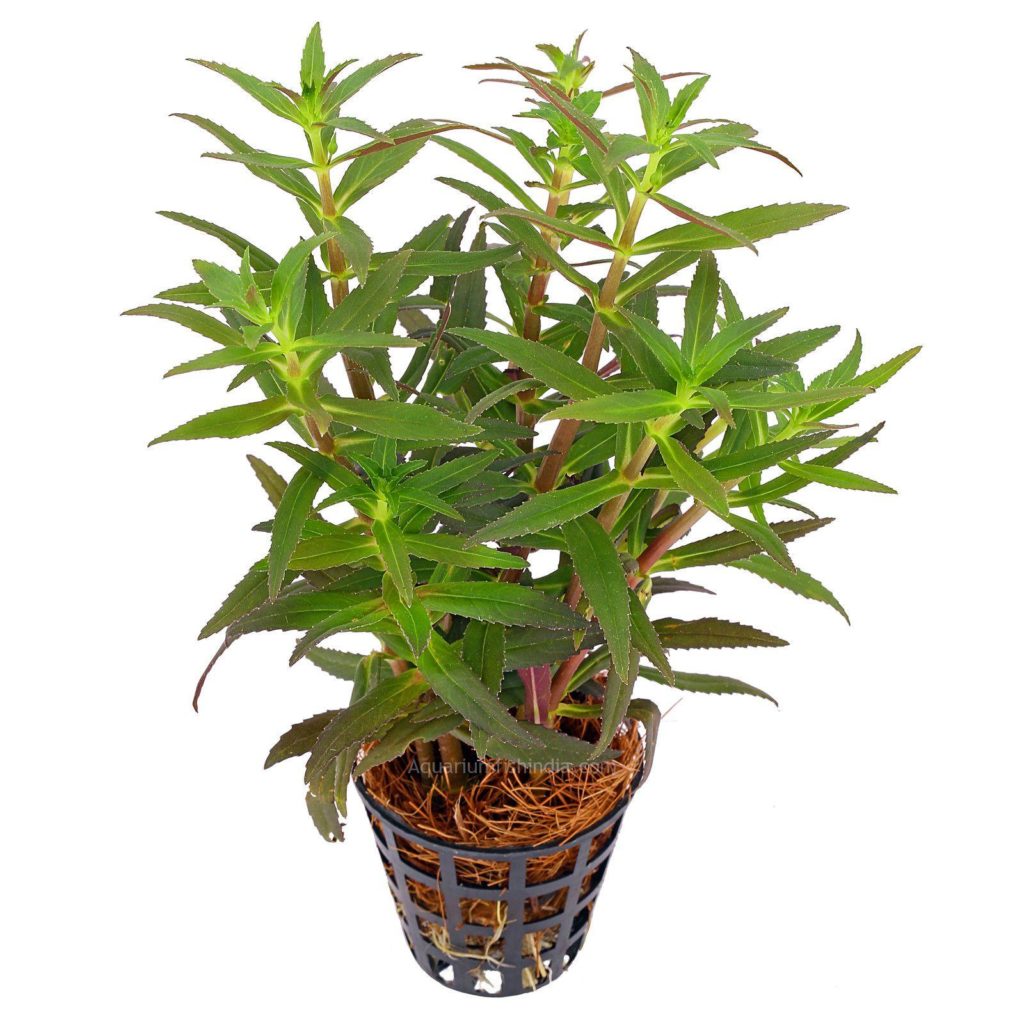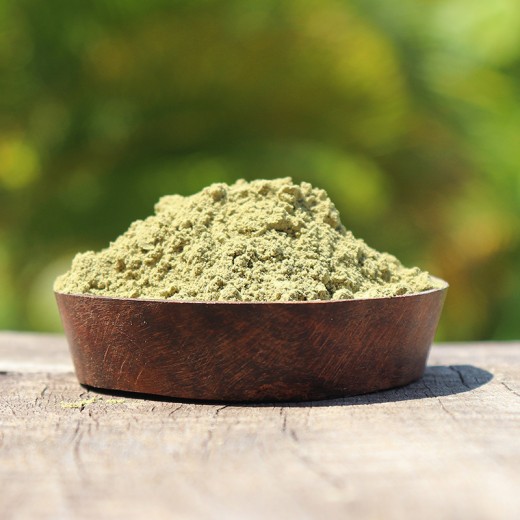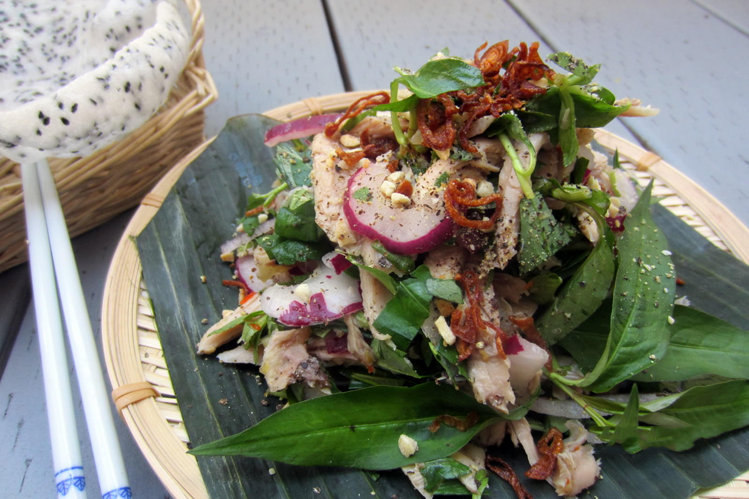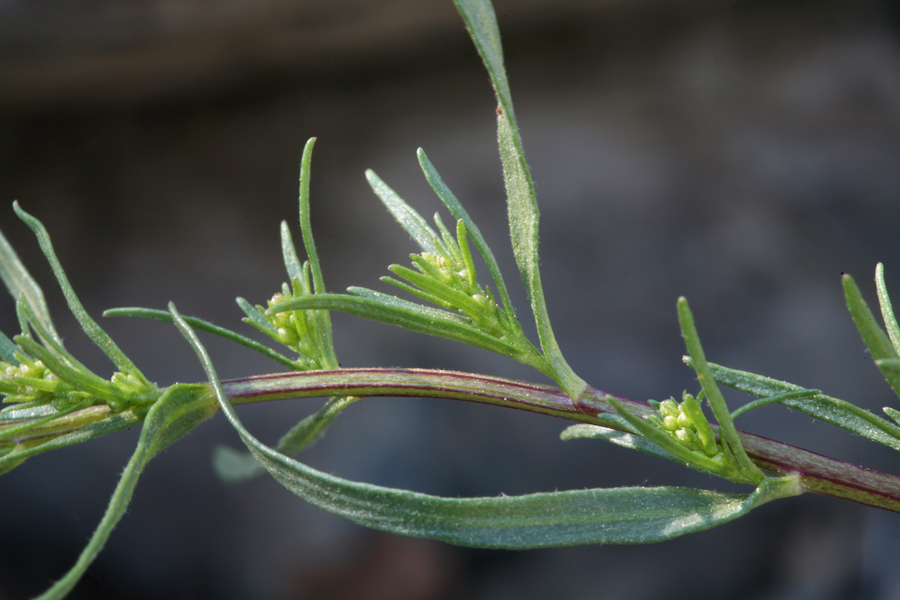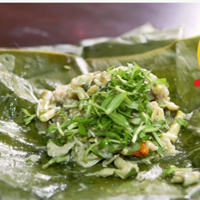| Rice paddy herb Quick Facts | |
|---|---|
| Name: | Rice paddy herb |
| Scientific Name: | Limnophila aromatica |
| Origin | India and Sri Lanka to Indo-China, southern China, Japan, Taiwan, throughout South-East Asia and northern Australia. |
| Colors | Initially green turning to brown as they mature |
| Shapes | Broadly ellipsoid, compressed capsules about 5-6 mm long with pointed tips |
| Taste | Sour, bitter |
| Health benefits | Support agalactia, foul ulcers, anorexia, galactic impurities, constipation, dyspepsia, inflammations, pharyngitis, fevers, reduce stress and sore throats. |
| Name | Rice paddy herb |
|---|---|
| Scientific Name | Limnophila aromatica |
| Native | From India and Sri Lanka to Indo-China, southern China, Japan, Taiwan, throughout South-East Asia and northern Australia |
| Common Names | Rice paddy herb, Swampleaf, Limnophila, Finger grass, rau om |
| Name in Other Languages | Bulgarian: Aromatna limnofila (ароматна лимнофила) Chinese: Zi su cao (紫苏草 ) English: Rice paddy herb, Swampleaf, Limnophila, Finger grass, rau om Estonian: Järvelemb Finnish: Tuoksukidusruoho French: Ambulie aromatique, limnophile aromatique German: Reisfeldpflanze Hindi: Kutra, Kutna Indonesia: Kehkehan, daun kardemom, selaseh ayer kecil Japanese: Shiso-Kusa (シソクサ) Khmer: Ma om Korean: Soyeob (소엽), So yeop pul (소엽풀) Lithuanian: Kvapioji Pelkenė Malay: Beremi, Kerak-kerak, Selaseh ayer kecil Malayalam: Manganari Papua New Guinea: Poikehkeh, ginibok Philippines: Angangi Polish: Limnofila Pachnąca Russian: Ambuliia aromatnaia (Амбулия ароматная) Sanskrit: Amragandha Sundanese: Kehkehan Tagalog: Angangi Thai: Ka yaeng (แขยง), Ma om (มะออม), Phak ga yaeng (ผักกะแยง ), Phak kha yaeng (ผักแขยง), Phak phaa (ผักพา), P̄hạk k̄hæyng (ผักแขยง), Kayang (แขยง) Vietnamese: Láng Hôm Nay, Một Vùng Rau, Mot Vung Rau, Rau Ngó, Rau Ngô, Rau Ngo, Rau Om Unidentified: Ginibok, Poikehkeh |
| Plant Growth Habit | Tropical, perennial plant |
| Growing Climates | Rice paddy fields, marshes, reservoirs, shallow ponds or marshy localities |
| Plant Size | Typically reaches 30 to 100 centimeters in height |
| Stem | Stout, erect, simple, 30 to 60 centimeters in length, and rarely branched above |
| Leaf | Leaves are linear-oblong or oblong-lanceolate, 2 to 6 centimeters in length, 0.5 to 1 centimeter in width, opposite and whorled, with pointed tip, rounded and clasping base, and toothed margins |
| Flowering season | March-December |
| Flower | Pink or pale purple, and borne singly or in whorls in inflorescences at the axils of the leaves, with long, very slender pedicels 1 to 1.5 centimeters long. Calyx is about 4 millimeters long, glandular, and divided into lanceolate segments. Corolla is 1.2 centimeters long |
| Fruit Shape & Size | Broadly ellipsoid, compressed capsules about 5-6 mm long with pointed tips |
| Fruit Color | Initially green turning to brown as they mature |
| Flavor/Aroma | Distinct citrus and cumin aroma, almost like a cross between lemon zest and cumin |
| Taste | Sour, bitter |
| Plant Parts Used | Whole plant, leaves, roots |
| Propagation | By Seed and Stem Cutting |
| Varieties |
|
| Health Benefits |
|
Plant Description
Rice paddy herb is a tropical, annual or perennial flowering plant that typically reaches 30 to 100 centimeters in height. The plant is found growing in rice paddy fields, marshes, reservoirs, shallow ponds and water-logged places in the tropics. The stems are thick in appearance but have a hollow center, creating a smooth, crisp, and watery texture. The pale green stems also have a light, succulent, and spongy consistency, lightly coated in fine hairs. The stems of the emergent form are purple in color. These plants seldom have aerial branches.
Leaves
The simple leaves are arranged on the stem in opposite pairs and are whorled. They are lanceolate-elliptic to ovate-lanceolate in shape. They grow up to a length of 2 cm to 6 cm and are generally 0.5 cm to 1 cm wide. The leaves have a dentate margin. The submerged leaf form is less rigid and bigger in size as compared to the emergent leaf form. The leaves are green with a purple underside, under high light conditions, the submerged leaves turn red. The leaves have a rounded clasping base, while the tip is pointed. The leaves have jagged margins. They are also smooth to the touch, thin, and pliable with finely serrated edges.
Flower
Rice paddy herb bears white, blue-purple, or pink flowers which are borne solitarily or appear in whorls in inflorescences. Flowers arise singly in leaf axils or in racemes at branch-ends or in leaf-axils and have long and extremely thin pedicels that measure anything between 1 cm and 1.5 cm. The calyx is glandular, roughly 4-6 mm in length, hairless or glandular velvet-hairy, and divided into sections that are lanceolate. The corolla measures 10.5-13.5 mm in length, pale pink, outside finely glandular, inside densely villous, posterior lobe emarginate, posterior stamens 2.5 mm long, villous, anterior stamens 4 mm long, glabrous. Flower-stalks are 0.5-2 cm, hairless or glandular. Bracteoles are linear to linear-lance shaped, about 1.5-2 mm long. Flowering normally takes place in between March-December.
Fruits
Fertile flowers are followed by broadly ellipsoid, compressed capsules about 5-6 mm long with pointed tips. They are initially green turning to brown as they mature. Rice paddy herb is one of the many culinary herbs used only or predominantly in Vietnamese cuisine. The flavor of rice paddy herb goes well with mild Vietnamese curries, like chicken curry.
History
Rice paddy herb is native to tropical and subtropical regions of Southeast Asia and has been growing wild since ancient times. The plants have an affinity for humid, warm temperatures and are mostly found in moist soil, swamplands, and areas with still water, such as rice paddy fields. Over time, it was introduced into Northern Australia and was also brought to North America in the 1970s by Vietnamese refugees from the Vietnam War. Today it is cultivated and found growing wild in India, China, Vietnam, Thailand, Sri Lanka, and Cambodia, and the plants are grown in specialized conditions in Japan, Australia, Europe, and the United States for sale at Asian markets and distributors.
Rice paddy herb varieties
Rice paddy herb has a few different types which are commonly available. As a species, Rice paddy herb is prone to variations which don’t warrant a separate species designation. Some of these variations have commercial appeal and are available from various aquarium plant suppliers. These types are best thought of as cultivars of Rice paddy herb. Here are some of the common types you’ll find for sale.
1. Limnophila Aromatica Mini
Limnophila Aromatica Mini features light green foliage which keeps its color even in moderate lighting. This type is ideal for foreground or mid ground use. Use this variety when you’re looking to grow a thick carpet across wide areas of an aquarium. This plant needs bright light, nutrients, added Co2 to grow its best. Still rare, it can be difficult to find this type in local fish stores, but it can be bought from online sources.
2. Limnophila Aromatica Red
Limnophila Aromatica Red is a smaller plant whose foliage will turn red with adequate lighting. Not all types of Limnophila Aromatica turn red as they grow. Buying this type will ensure you are getting a variety which is capable of producing red foliage.
3. Limnophila Aromatica Green
Limnophila Aromatica Green is a variety which won’t produce red foliage even under very bright lighting. If you want a Limnophila Aromatica with uniform green coloration, this is the variety to get.
Health benefits of Rice paddy herb
Rice paddy herb also called as ‘limophila aromatic’ botanically is a common herb which is known to be extensively grown in the Southeast regions of Asia. This herb is known to contain numerous benefits for heath as wellbeing and is known to be an active ingredient in numerous Cambodian as well as Vietnamese cuisine. It is known to contain a tangy taste and is utilized as a flavoring compound in numerous cuisines. Listed below are some of the popular health benefits of using rice paddy herb
1. Have expectorant properties
Rice paddy herb has been known to contain expectorant properties and hence it is an effective cure against numerous respiratory issues such as cold and cough.
2. De-stressing effects
Rice paddy herb has been known to contain certain compounds which tend to sooth the nerves and hence allow you to calm down the levels of tension.
3. Good for pregnant women
Rice paddy herb has been known to be effective for pregnant women as it tends to improve the milk formation while at the same time improve the taste of same.
4. Have anti-septic properties
Rice paddy herb has been known to be effective in treating inflammation as well as infections caused due to wounds and injuries. It tends to have healing effect and can cause speedier recovery.
Traditional uses and benefits of Rice paddy herb
- The leaves are antispasmodic, appetizer, disinfectant, diuretic, expectorant, febrifuge and galactagogue.
- Leaves are used for poulticing sores on legs.
- Decoction of leaves and roots are given for fevers.
- It is also used for foul ulcers, agalactia, galactic impurities, anorexia, dyspepsia, helminthiasis, constipation, inflammations and strangury.
- Plant juice is used as cooling medicine for fever and pharyngitis.
- It is a source of vitamins A and C to boost the immune system, reduce inflammation, and promote collagen growth in the skin.
- The herb also provides calcium and phosphorus to strengthen bones and teeth, iron to develop the protein hemoglobin for oxygen transport through the bloodstream.
- Leaves are used in herbal infusions, steeped in hot water and consumed to reduce fevers and sore throats, or made into a paste and used topically over wounds and skin irritations.
- Leaves are crushed and inhaled as a calming scent believed to reduce stress.
- Leaves of this plant immersed are used to relieve fever and mucous decoction.
- Refreshing aroma of leaves is also used to destress body and mind.
- In Indonesia and Peninsular Malaysia, the sap of the leaves is used to clean wounds, and a decoction of the leaves is given in fevers.
- People use the leaves of the plant to patients having fevers, gravel in the kidneys, haematuria etc.
- It is also thought to stimulate the appetite and to evacuate mucus from the bronchial tubes.
- It is the best plant to calm the stomach after eating a bit too much.
- Sap of this plant’s leaves is also used to rinse injuries and sores on the limbs.
- Eating the plant is thought to calm the stomach after eating a durian.
- It is considered to be a rather strong treatment.
- Consuming two tablespoon of this herb’s leaves soaked in hot water may help to get respite from excessive mucous and fever.
- Leaves of rice paddy herb are well-known for their wonderfully refreshing fragrance.
- Refreshing fragrance will help to alleviate stress from the body and the mind.
- Juice extracted from the herb is administered to people with fever and lactating mothers when their milk becomes sour.
- Plant’s juice is also used in the form of a cooling medicine to cure pharyngitis and fevers.
- Oil extracted from rice paddy herb leaves possesses antiseptic properties.
Culinary Uses
- Plant is used as spinach, eaten raw or steamed.
- In Java, plant is eaten raw or steamed; thought to be good for quieting the stomach after eating durian.
- It is a popular culinary herb in Vietnamese cuisine.
- It is used in all traditional Cambodian soup dishes.
- Leaves should be washed and gently torn, chopped, or crushed to release their flavor, and they can be sprinkled into salads, minced into dips and marinades, or used as an edible garnish for roasted meats, light sauces, or grain dishes.
- Leaves are traditionally served fresh in the center of the dinner table, along with other herbs and raw vegetables.
- It can also be sautéed or steamed as a simple side dish or the stems can be roughly chopped and added to stir-fries.
- In Cambodia, it is placed on the roof of houses and dehydrated for extended use as a dried herb.
- It pairs well with meats including poultry, beef, pork, and fish, other herbs such as lemongrass, basil, and mint, steamed rice, lemon, lime, bell peppers, peas, broccoli, water spinach, carrots, and peanuts.
- Paddy grass is traditionally harvested and used as a fresh finishing herb in soups, curries and stir-fries.
- In extensively used in fish soup, meat or fish dishes for its special flavor.
Recipes
Shredded bamboo shoot with rice paddy herbs
Ingredients
- 1 bowl of shredded steamed bamboo shoot, you can buy raw bamboo shoot and boiled it
- 200 g of pork
- 1 small bowl of rice paddy herb
- 6 fresh chili, more or less
- 6 stalks of lemongrass
- 1 small bowl of yanang leaves extract
- 1 small bowl of khao beua (soaked sticky rice pounded), add a bit of water
- ½ tablespoon of salt
- 2 tablespoons of fish sauce
- 1 tablespoon of oyster sauce
Directions
- Cut rice paddy herbs
- Chop pork
- Bring a big bowl; add boiled shredded bamboo shoot, minced pork, chili, lemongrass, rice paddy herbs, Yanang leaves extract, Khao beua.
- Seasoning with salt, fish sauce, and oyster sauce. Mix well together and adjust the taste
- Wrap with banana leaves and steam it about 30mns. Then open the wrap and eat with sticky rice.
Rice Paddy Herb Omelet
Ingredients
- 1 bunch of rice paddy herb (Discard any yellow leaves or branch if there are any. Wash them thoroughly, and dried spin them. After that cut them into small pieces crosswise. Use a measuring cup to measure out 1 + 1/2 cup.)
- 1 medium-size of ripe tomato. Wash, slice and cut them into cubes, size of your ring’s finger
- 2 cloves of garlic. Peeled, crushed and chopped them roughly
- 5 medium chicken eggs
- Fish sauce (Three Blue Crabs Brand)
- Cooking oil
- Pinch of sea salt
- Pinch of sugar
Directions
- In a clean bowl, crack 5 chicken eggs and set it aside
- Place a clean medium skillet on stove-top, when it’s hot, drizzle a little of cooking oil, chopped garlic, and the chopped rice paddy herb.
- Give it a quick stir around. Season it with a pinch of sea salt, and stir it again.
- Take off the stove-top, transfer the briefly cooked rice paddy herb into a clean bowl
- Place that same skillet back to the stove-top, drizzle a little more cooking oil and chopped garlic.
- When the garlic turns light brown pour in your cubes tomato. Season it with a pinch of sea salt and a pinch of sugar.
- Stir and let the tomato cooked briefly. Turn off the stove and set the tomato aside.
- By now the rice paddy herb cools down a bit. Combine it with the chicken egg, add the cooked tomato. Give them all a good beat to cooperate everything together.
- In this bowl of egg mixture, drizzle an about 1 tablespoon of fish sauce, ground black or white pepper.
- Place a medium size non-stick skillet on the stove-top. Drizzle in a little cooking oil and chopped garlic, and then pour in the egg mixture. Cover with tight lid let it simmer on low heat
- When the egg surface is dried and solid, flip it to the other side cook for another good 5 minutes.
- Transfer the rice paddy herbs omelet to a cutting board; let it cool down for about 5 minutes. Use a sharp knife to cut them whatever size you want. Can be eaten by itself as a snack or have them with your steamed rice.
Other Facts
- It is able to live completely submerged, and as such it is a popular aquarium plant.
- The submerged leaf form is less rigid and bigger than the emergent leaf form, it is green with a purple underside, turning completely red under high light conditions.
- It is also ideal for being used as a backdrop in fish tanks and aquariums.
- Cambodians residing in rural areas store the rice paddy herb on the roofs of their houses for future use.
- Rice paddy herb is an integral part of Vietnamese cuisines.
- After the Vietnam War, the Vietnamese immigrants introduced this plant to North America in the late 1970s.
References:
https://www.itis.gov/servlet/SingleRpt/SingleRpt?search_topic=TSN&search_value=507349#null
https://gd.eppo.int/taxon/LIOAR
http://www.theplantlist.org/tpl1.1/record/tro-29200312
http://www.stuartxchange.com/Angangi.html
https://en.wikipedia.org/wiki/Limnophila_aromatica
http://www.flowersofindia.net/catalog/slides/Rice%20Paddy%20Herb.html
https://indiabiodiversity.org/species/show/227584
https://biodiversity.bt/species/show/3475?userGroupWebaddress=
https://www.nparks.gov.sg/florafaunaweb/flora/5/6/5657
https://plants.usda.gov/home/classification/51104
http://www.efloras.org/florataxon.aspx?flora_id=2&taxon_id=200020693
https://tropical.theferns.info/viewtropical.php?id=Limnophila+aromatica
https://elmaskincare.com/herbs/herbs_rice_paddy.htm
https://davesgarden.com/guides/pf/go/126752/#b
https://plants.usda.gov/home/plantProfile?symbol=LIAR11


